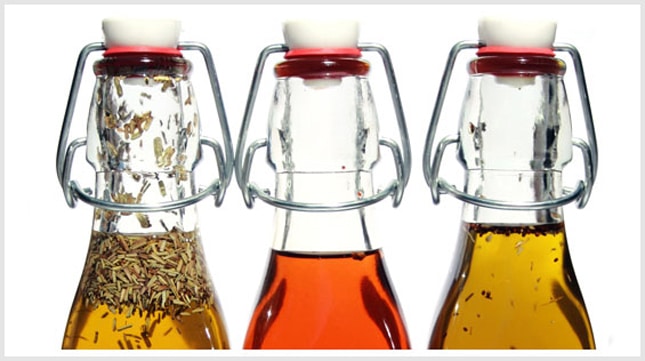
THERE ARE MANY OILS WE USE FOR FOOD AND EVERY OIL OFFERS ITS OWN SPECIFIC NUTRITIONAL BENEFIT.
Just about every culture in the world has figured out how to squeeze oils out of local plants, which can later be drizzled on food, hot or cold.
You can use animal fats to cook foods also, but plant-based oils — olive, corn, peanut, canola, soybean, sesame, safflower and walnut, to name a few — generally have superior health benefits when consumed in the right proportions. Many are high in omega-3 fatty acids, something that is largely deficient in Western diets, and most oils help us absorb vitamins A, D, E and K that are elsewhere in our diet. Anyone encountering hair loss needs these nutrients to preserve what hair remains and to promote healthier looking skin.
But every oil offers its own specific nutritional benefit. Each responds differently to heat, with at least one (flaxseed oil) losing its best nutritive characteristic when heated. The following is a primer on cooking oils — where they taste best, the point at which temperature degrades the oil to something less tasty and less healthy (the “smoke point”), what nutrients they offer and that particular oil’s disadvantages, if any.
Canola oil
- Best applications: Mild flavor and aroma, good for deep-frying, baking, sautéing and salad dressings.
- Recommended cooking temperatures: Good up to about 435 degrees F, so it can be used in deep-frying and baking as well as sautéing.
- Nutrition advantages: Lowest among all cooking oils in saturated fat, medium in polyunsaturated and high in monounsaturated fats.
- Disadvantages: Extended high heat might convert fatty acids into trans fats. Second only to flaxseed in omega-3 fatty acid content, but with a higher proportion of omega-6 fatty acids (which somewhat cancel the omega-3 benefits).
Corn oil
- Best applications: Relatively tasteless and inexpensive, therefore most economical in recipes that call for deep-frying.
- Recommended cooking temperatures: Up to 450 degrees F, therefore useful in pan-frying and deep-frying.
- Nutrition advantages: High in polyunsaturated fats.
- Disadvantages: Used in many commercial food-processing applications (margarine, bottled salad dressings, mayonnaise), so you’re probably already getting a lot of it.
Flaxseed oil
- Best applications: Room temperature uses, mostly on salads.
- Recommended cooking temperatures: No heat.
- Nutrition advantages: Among the highest in omega-3 fatty acids, which essentially make the entire cardiovascular system work better and which reduce inflammation of the arteries and possibly other parts of the body, as well.
- Disadvantages: Has to be refrigerated; cannot be used in cooking without loss of the omega-3s.
Grape seed oil
- Best applications: Salad dressings, plus pan-seared foods such as seafood.
- Recommended cooking temperatures: Withstands slightly higher temperatures (up to about 425 degrees F), making it a bit more appropriate for foods that require it.
- Nutrition advantages: Low in saturated fat and high in polyunsaturated fat.
- Disadvantages: Not available in many grocery stores.
Olive oil
- Best applications: This is wisely and most commonly used as a salad dressing oil, usually paired with vinegar, lemon juice and spices. But it is also common in Mediterranean-style cooking for light frying with vegetables.
- Recommended cooking temperatures: Room temperature as a salad dressing or in foods that are sautéed at low to medium temperatures (under 400 degrees F). Not appropriate for deep-frying or baked goods.
- Nutrition advantages: It is among the healthiest choices, particularly in the extra virgin variety, because it is low in saturated fats (bad fats), and high in monounsaturated fats (good fats).
- Disadvantages: Stronger taste may overwhelm some foods.
Peanut oil
- Best applications: Wok-frying, as it has a higher smoke point; lends a rich, roasted, nutty flavor. Also popcorn, sautéing and grilling vegetables.
- Recommended cooking temperatures: Up to 450 degrees F, among the highest temperatures a vegetable oil can tolerate.
- Nutrition advantages: Contains resveratrol, otherwise found in grapes and red wine, which may offer cardiovascular and cancer-prevention benefits.
- Disadvantages: Yet, the American Heart Association excludes peanut oil from its list of recommendations because it is higher in saturated fats than other cooking oils (about 18 percent).
Sesame oil
- Best applications: Asian foods are characteristically flavored with sesame oil, with darker varieties delivering more pungent tastes.
- Recommended cooking temperatures: Refined oil at 350 degrees F, semirefined at 450 degrees F.
- Nutrition advantages: High in vitamin E as well as copper, calcium, magnesium, vitamin B6 and iron.
- Disadvantages: Strong taste might overwhelm a dish, and the dark variety is less appropriate for cooking.
Sunflower oil
- Best applications: Good for deep- and pan-frying, sautéing and baking
- Recommended cooking temperatures: High, up to 450 degrees F, making it a good cooking oil.
- Nutrition advantages: Low in saturated fat, high in vitamin E; being used in the food-manufacturing industry to eliminate trans fats in products.
- Disadvantages: Nearly flavorless.
Walnut oil
- Best applications: Room-temperature addition to salads or as a finishing oil on chicken and fish; can be used to partially supplement butter in baked goods.
- Recommended cooking temperatures: Best to serve at room temperature.
- Nutrition advantages: Able to lower triglycerides, favorably affecting heart health; high in omega-3 fatty acids.
- Disadvantages: Expensive; more often carried by specialty grocers.
It should be noted that all oils are pure fat, and as such they are high in calories — about 120 calories per tablespoon. But oils are essential to health, taste and function. It probably makes sense to keep a variety on hand, not just for cooking and taste diversity but for your health, as well.